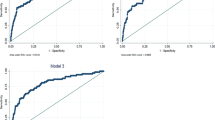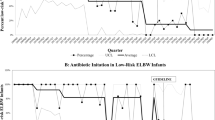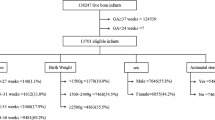Abstract
Objective
To determine delivery risk phenotype-specific incidence of early-onset sepsis (EOS) among preterm infants.
Study design
Retrospective cohort study of infants born <35 weeks’ gestation at four perinatal centers during 2017–2021. Infants were classified into one of six delivery risk phenotypes incorporating delivery mode, presence of labor, and duration of rupture of membranes (ROM). The primary outcome was EOS incidence within the overall cohort and each risk phenotype.
Results
Among 2937 preterm infants, 21 had EOS (0.7%, or 7.1 cases/1000 preterm infants). The majority of EOS cases (13/21, 62%) occurred in the setting of prolonged ROM ≥ 18 h, with a phenotype incidence of 23.8 cases/1000 preterm infants. There were no EOS cases among infants born by cesarean section without ROM (with or without labor), nor via cesarean section with ROM < 18 h without labor.
Conclusion
Delivery risk phenotyping may inform EOS risk stratification in preterm infants.
This is a preview of subscription content, access via your institution
Access options
Subscribe to this journal
Receive 12 print issues and online access
$259.00 per year
only $21.58 per issue
Buy this article
- Purchase on Springer Link
- Instant access to full article PDF
Prices may be subject to local taxes which are calculated during checkout


Similar content being viewed by others
Data availability
A de-identified dataset may be made available upon reasonable request.
References
Stoll BJ, Puopolo KM, Hansen NI, Sánchez PJ, Bell EF, Carlo WA, et al. Early-Onset Neonatal Sepsis 2015 to 2017, the Rise of Escherichia coli, and the Need for Novel Prevention Strategies. JAMA Pediatr. 2020;174:e200593.
Flannery DD, Edwards EM, Puopolo KM, Horbar JD. Early-onset sepsis among very preterm infants. Pediatrics. 2021;148:2021052456.
Schrag SJ, Farley MM, Petit S, Reingold A, Weston EJ, Pondo T, et al. Epidemiology of Invasive Early-Onset Neonatal Sepsis, 2005 to 2014. Pediatrics. 2016;138:e20162013.
Flannery DD, Ross RK, Mukhopadhyay S, Tribble AC, Puopolo KM, Gerber JS. Temporal Trends and Center Variation in Early Antibiotic Use Among Premature Infants. JAMA Netw Open. 2018;1:e180164.
Mukhopadhyay S, Bryan M, Dhudasia MB, Quarshie W, Gerber JS, Grundmeier RW, et al. Intrapartum group B Streptococcal prophylaxis and childhood weight gain. Arch Dis Child - Fetal Neonatal Ed. 2021;106:649–56.
Koebnick C, Sidell MA, Getahun D, Tartof SY, Rozema E, Taylor B, et al. Intrapartum Antibiotic Exposure and Body Mass Index in Children. Clin Infect Dis. 2021;73:e938–46.
Kuppala VS, Meinzen-Derr J, Morrow AL, Schibler KR. Prolonged initial empirical antibiotic treatment is associated with adverse outcomes in premature infants. J Pediatr. 2011;159:720–5.
Cantey JB, Huffman LW, Subramanian A, Marshall AS, Ballard AR, Lefevre C, et al. Antibiotic Exposure and Risk for Death or Bronchopulmonary Dysplasia in Very Low Birth Weight Infants. J Pediatr. 2017;181:289–93.e1.
Ting JY, Roberts A, Sherlock R, Ojah C, Cieslak Z, Dunn M, et al. Duration of Initial Empirical Antibiotic Therapy and Outcomes in Very Low Birth Weight Infants. Pediatrics. 2019;143:e20182286.
Letouzey M, Lorthe E, Marchand-Martin L, Kayem G, Charlier C, Butin M, et al. Early Antibiotic Exposure and Adverse Outcomes in Very Preterm Infants at Low Risk of Early-Onset Sepsis: The EPIPAGE-2 Cohort Study. J Pediatr. 2022;243:91–98.e4.
Cotten CM, Taylor S, Stoll B, Goldberg RN, Hansen NI, Sanchez PJ, et al. Prolonged Duration of Initial Empirical Antibiotic Treatment Is Associated With Increased Rates of Necrotizing Enterocolitis and Death for Extremely Low Birth Weight Infants. Pediatrics. 2009;123:58–66.
Cantey JB, Pyle AK, Wozniak PS, Hynan LS, Sánchez PJ. Early Antibiotic Exposure and Adverse Outcomes in Preterm, Very Low Birth Weight Infants. J Pediatr. 2018;203:62–7.
Kuzniewicz MW, Puopolo KM, Fischer A, Walsh EM, Li S, Newman TB, et al. A Quantitative, Risk-Based Approach to the Management of Neonatal Early-Onset Sepsis. JAMA Pediatr. 2017;171:365–71.
Flannery DD, Mukhopadhyay S, Morales KH, Dhudasia MB, Passarella M, Gerber JS, et al. Delivery Characteristics and the Risk of Early-Onset Neonatal Sepsis. Pediatrics. 2022;149:e2021052900.
Garber SJ, Dhudasia MB, Flannery DD, Passarella MR, Puopolo KM, Mukhopadhyay S. Delivery-based criteria for empiric antibiotic administration among preterm infants. J Perinatol. 2021;41:255–62.
Puopolo KM, Mukhopadhyay S, Hansen NI, Cotten CM, Stoll BJ, Sanchez PJ, et al. Identification of Extremely Premature Infants at Low Risk for Early-Onset Sepsis. Pediatrics. 2017;140:e20170925.
Mukhopadhyay S, Puopolo KM. Clinical and Microbiologic Characteristics of Early-onset Sepsis Among Very Low Birth Weight Infants: Opportunities for Antibiotic Stewardship. Pediatr Infect Dis J. 2017;36:477–81.
Mukhopadhyay S, Puopolo KM. Risk assessment in neonatal early onset sepsis. Semin Perinatol. 2012;36:408–15.
Puopolo KM, Benitz WE, Zaoutis TE. Management of neonates born at ≤34 6/7 weeks’ gestation with suspected or proven early-onset bacterial sepsis. Pediatrics. 2018;142:e20182896.
Manuck TA, Esplin MS, Biggio J, Bukowski R, Parry S, Zhang H, et al. The Phenotype of Spontaneous Preterm Birth: Application of a Clinical Phenotyping Tool. Am J Obstet Gynecol. 2015;212:487.
Stout MJ, Demaree D, Merfeld E, Methodius Ã, Tuuli G, Wambach JA, et al. Neonatal Outcomes Differ after Spontaneous and Indicated Preterm Birth. Am J Perinatol. 2018;35:494–502.
Henderson JJ, McWilliam OA, Newnham JP, Pennell CE. Preterm birth aetiology 2004-2008. Maternal factors associated with three phenotypes: spontaneous preterm labour, preterm pre-labour rupture of membranes and medically indicated preterm birth. J Matern Neonatal Med. 2012;25:642–7.
Stout MJ, Busam MR, Macones GA, Tuuli MG. Spontaneous and Indicated Preterm Birth Subtypes: Inter-observer Agreement and Accuracy of Classification. Am J Obstet Gynecol. 2014;211:530.e1.
Goldenberg RL, Culhane JF, Iams JD, Romero R. Epidemiology and causes of preterm birth. Lancet. 2008;371:75–84.
Gimenez LG, Krupitzki HB, Momany AM, Gili JA, Poletta FA, Campaña H, et al. Maternal and neonatal epidemiological features in clinical subtypes of preterm-birth. J Matern Fetal Neonatal Med. 2016;29:3153.
Flannery DD, Gouma S, Dhudasia MB, Mukhopadhyay S, Pfeifer MR, Woodford EC, et al. SARS-CoV-2 seroprevalence among parturient women in Philadelphia. Sci Immunol. 2020;5:eabd5709.
Osterman MJK, Hamilton BE, Martin JA, Driscoll AK, Valenzuela CP. Births: Final Data for 2021. Natl Vital Stat Reports. 2023;72:15–44.
Kamath-Rayne BD, DeFranco EA, Chung E, Chen A. Subtypes of Preterm Birth and the Risk of Postneonatal Death. J Pediatr. 2013;162:28–34.
Lynch AM, Wagner BD, Hodges JK, Thevarajah TS, McCourt EA, Cerda AM, et al. The relationship of the subtypes of preterm birth with retinopathy of prematurity. Am J Obstet Gynecol. 2017;217:354.e1–354.
Kimberlin DF, Hauth JC, Owen J, Bottoms SF, Iams JD, Mercer BM, et al. Indicated versus spontaneous preterm delivery: An evaluation of neonatal morbidity among infants weighing </=1000 grams at birth. Am J Obstet Gynecol. 1999;180:683–9.
Villar J, Papageorghiou AT, Knight HE, Gravett MG, Iams J, Waller SA, et al. The preterm birth syndrome: A prototype phenotypic classification. Am J Obstet Gynecol. 2012;206:119–23.
Kramer MS, Papageorghiou A, Culhane J, Bhutta Z, Goldenberg RL, Gravett M, et al. Challenges in defining and classifying the preterm birth syndrome. Am J Obstet Gynecol. 2012;206:108–12.
Mukhopadhyay S, Underwood MA. Phenotyping preterm infants at birth to predict infection risk. Pediatr Res. 2021;90:508–9.
Klinger G, Levy I, Sirota L, Boyko V, Reichman B, Lerner-Geva L. Epidemiology and risk factors for early onset sepsis among very-low-birthweight infants. Am J Obstet Gynecol. 2009;201:38.e1–38.
Ofman G, Vasco N, Cantey JB. Risk of Early-Onset Sepsis following Preterm, Prolonged Rupture of Membranes with or without Chorioamnionitis. Am J Perinatol. 2016;33:339–42.
Pinto S, Malheiro MF, Vaz A, Rodrigues T, Montenegro N, Guimarães H. Neonatal outcome in preterm deliveries before 34-week gestation—the influence of the mechanism of labor onset. J Matern Neonatal Med. 2019;32:3655–61.
Gagliardi L, Rusconi F, Bellù R, Zanini R. Association of Maternal Hypertension and Chorioamnionitis With Preterm Outcomes. Pediatrics. 2014;134:e154–61.
Lu C-Q, Lin J, Yuan L, Zhou J-G, Liang K, Zhong Q-H, et al. Pregnancy induced hypertension and outcomes in early and moderate preterm infants. Pregnancy Hypertens. 2018;14:68–71.
Giannoni E, Agyeman PKA, Stocker M, Posfay-Barbe KM, Heininger U, Spycher BD, et al. Neonatal Sepsis of Early Onset, and Hospital-Acquired and Community-Acquired Late Onset: A Prospective Population-Based Cohort Study. J Pediatr. 2018;201:106–14.
Wortham JM, Hansen NI, Schrag SJ, Hale E, Van Meurs K, Sánchez PJ, et al. Chorioamnionitis and Culture-Confirmed, Early-Onset Neonatal Infections. Pediatrics. 2016;137:e20152323.
Funding
SAC reports receiving research funding from the National Heart, Lung and Blood Institute of the National Institutes of Health (T32HL007891). JT receives research funding from the Michigan Department of Health and Human Services. KJD is supported by the Eunice Kennedy Shriver National Institute of Child Health and Human Development (K23HD091365). JDC is supported by the National Heart, Lung, and Blood Institute of the National Institutes of Health (K24HL115354). KMP reports receiving research funding from the National Institutes of Health, from two contracts with the Centers for Disease Control and Prevention, and from the Children’s Hospital of Philadelphia.
Author information
Authors and Affiliations
Contributions
SAC contributed to study design, performed data collection and data analysis, and wrote the manuscript. SM, JDC, and KMP contributed to study design, interpreted the results, and critically reviewed the manuscript. JT and KJD interpreted the results and critically reviewed the manuscript.
Corresponding author
Ethics declarations
Competing interests
The authors declare no competing interests.
Additional information
Publisher’s note Springer Nature remains neutral with regard to jurisdictional claims in published maps and institutional affiliations.
Supplementary information
Rights and permissions
Springer Nature or its licensor (e.g. a society or other partner) holds exclusive rights to this article under a publishing agreement with the author(s) or other rightsholder(s); author self-archiving of the accepted manuscript version of this article is solely governed by the terms of such publishing agreement and applicable law.
About this article
Cite this article
Coggins, S.A., Mukhopadhyay, S., Triebwasser, J. et al. Association of delivery risk phenotype with early-onset sepsis in preterm infants. J Perinatol 43, 1166–1172 (2023). https://doi.org/10.1038/s41372-023-01743-z
Received:
Revised:
Accepted:
Published:
Issue Date:
DOI: https://doi.org/10.1038/s41372-023-01743-z



